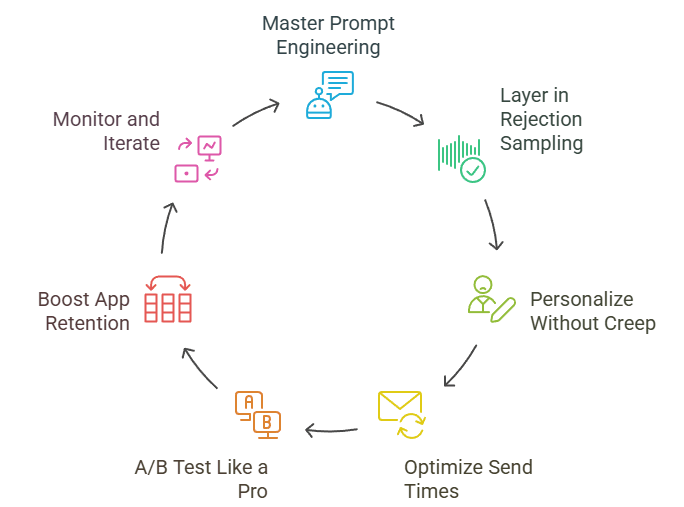Hey there, ever scrolled through your inbox and deleted half the emails before even opening them? You’re not alone. In a world where attention spans are shorter than a TikTok video, keeping users hooked feels like chasing fireflies at dusk. But what if I told you there’s a tool that could flip the script? Enter generative AI for user engagement, the tech that’s quietly revolutionizing how apps and emails grab (and hold) our focus.
Picture this: instead of bland notifications that get ignored, you get tailored, witty messages that make you click “just to see.” That’s the magic we’re diving into today. We’ll unpack how generative AI for user engagement isn’t just hype; it’s a practical powerhouse backed by real results. From boosting email opens to keeping users glued to your app, we’ll cover the nuts and bolts, throw in some eye-opening stats, and share stories from brands that nailed it.
By the end, you’ll have seven actionable ways to weave this into your world. No fluff, just strategies that work. Ready to turn passive scrollers into loyal fans? Let’s jump in.
Table of Contents
Why Generative AI is Revolutionizing User Interactions
Let’s start with the basics. Generative AI for user engagement means using smart models, like those from OpenAI or similar, to create content on the fly. Think dynamic subject lines, personalized feeds, or even chat responses that feel human. It’s not about replacing your team; it’s about amplifying what makes your brand tick.
Why now? Users are drowning in noise. The average email open rate hovers around 35.6%. That’s barely one in three messages getting a glance. On the app side, a whopping 72% of users launch an app five times or fewer in their first 30 days. Ouch. But generative AI flips that by crafting experiences that resonate.
Take emails: 347 billion get sent daily in 2025. Standing out requires more than a catchy emoji. Generative AI for user engagement analyzes user data to spit out variations that hit the sweet spot, curious, relevant, timely. Result? Higher clicks (up to 60% of users tap links in marketing emails).
And it’s not just emails. In apps, it powers recommendation engines that keep sessions flowing. One study showed AI-driven tweaks can extend time on page by 35% in interactive tools. That’s real stickiness.
But here’s the kicker: without smart tweaks, generative AI can churn out generic drivel. That’s where techniques like rejection sampling in AI come in. More on that soon. For now, know this, generative AI for user engagement isn’t a luxury; it’s your edge in a crowded digital arena.
The Pitfalls of Vanilla Generative AI (And How to Dodge Them)
You might think plugging in a generative AI tool will instantly juice your metrics. Spoiler: it won’t. Off-the-shelf models often spit out safe, soulless content. Remember those robotic customer service replies? Yeah, that’s the risk.
Common traps? Hallucinations, where AI invents facts that erode trust. Or bland outputs that blend into the background. In one experiment, unchecked AI-generated email subjects tanked clicks by 44% compared to human ones. Why? They sounded too salesy or off-base.
Then there’s scalability. Training on massive datasets costs a fortune, and without personalization, you’re firing blanks. Social media engagement sits at a measly 0.71% on average. Generative AI for user engagement shines when you layer in AI-driven content personalization, but skip the fine-tuning, and you’re back to square one.
Spotting the Red Flags Early
- Inauthenticity: If outputs feel like corporate speak, users bounce.
- Irrelevance: No user history? Expect yawns.
- Overkill: Too many variations without testing leads to analysis paralysis.
The fix? Hybrid approaches. Blend human oversight with AI smarts. And that’s our segue to rejection sampling in AI, a method that weeds out the weak stuff before it hits your audience.
Rejection Sampling in AI: Filtering Gold from the Noise
Alright, let’s geek out a bit. Rejection sampling in AI is like being your own bouncer at a club. You generate a bunch of options, score them against a “cool factor” model, and only let the winners through. It’s a staple in reinforcement learning, but for generative AI for user engagement, it’s a lifesaver.
How does it work? Step one: Prompt your AI to create candidates, say, 10 subject line ideas for an email. Step two: Feed them into a lightweight reward model (trained on past engagement data) that rates each on predicted appeal. Anything below a threshold? Rejected. Fallback to a safe default, like the original human version.
Benefits? Huge. It boosts text quality by ensuring coherence and relevance. In practice, it can lift engagement by filtering out hallucinations, those wild fabrications that make users cringe. One setup saw a 1% session increase just from smarter selections.
For apps, rejection sampling in AI refines push notifications. Imagine generating alerts for a fitness app: “Crush your PR today?” vs. a generic “Workout time!” The sampler picks the punchy one, based on what drove past opens.
It’s cost-effective too. Cache your generations (process once, reuse often), and you’re golden. No need for endless API calls. Plus, it scales, retrain the reward model quarterly on fresh A/B data to stay sharp.
In short, rejection sampling in AI turns generative AI for user engagement from a gamble into a strategy. It’s not magic; it’s methodical pruning for peak performance.
Case Studies: Brands Crushing It with Generative AI for User Engagement
Theory’s great, but results? That’s where the fun is. Let’s look at brands that harnessed generative AI for user engagement and saw the needle move. These stories show it’s doable, even if you’re not a tech giant.
Retail Giant Sees 4x Engagement Spike
A major retail chain was struggling with stagnant email campaigns. Open rates? Stuck at 20%. They rolled out AI-driven content personalization using generative models to craft product recs in subject lines. But to avoid duds, they layered in rejection sampling in AI, scoring lines for click potential based on historical data.
Outcome? A whopping 4x increase in customer engagement. Clicks soared, and cart abandonment dropped 15%. The key? Sampling rejected overly promotional phrasing, opting for conversational nudges like “Your summer wardrobe upgrade awaits, peek inside.” Users felt seen, not sold to. This ties right into improving email open rates with AI, proving personalization pays off.
Beauty Brand's AI Makeover Boosts Conversions
Over in beauty, a global brand used generative AI for user engagement in their virtual try-on tool. Users upload selfies; AI generates outfit suggestions. Early versions? Clunky and generic. Enter rejection sampling in AI to filter for diverse, flattering outputs.
Results were stunning: 35% more time spent interacting and 22% higher conversions. One user raved, “It nailed my vibe, felt like a personal stylist.” By rejecting low-relevance gens (e.g., suggesting neon for a minimalist), they built trust. This showcases strategies to increase app retention, as repeat visits jumped 28%.
Social App's Notification Overhaul
A neighborhood-focused social app (think local chats and alerts) faced notification fatigue. Users ignored 80% of pushes. They turned to generative AI for user engagement, generating teaser subjects from post content. Rejection sampling in AI was the hero, a reward model trained on A/B tests picked extracts that beat originals 65% of the time.
The payoff? 1% lift in daily sessions, 0.4% more weekly active users, and a 1% revenue bump from ads. For a post about community events, it swapped a dull “Event update” for “Join the block party buzz tonight!” Engagement metrics proved it: opens up 12%. This real-world win highlights how improving email open rates with AI extends to apps, fostering community stickiness.
These cases aren’t outliers. They’re blueprints. Notice the pattern? Generative AI for user engagement thrives with rejection sampling in AI as the guardrail, plus relentless testing.
7 Game-Changing Ways to Implement Generative AI for User Engagement
Enough inspiration, time to roll up your sleeves. Here are seven practical ways to supercharge your efforts. Each ties in AI-driven content personalization or other primaries, with tips drawn from pros.

- Master Prompt Engineering for Emails: Start simple. Feed your generative AI post snippets with instructions like “Extract the hook in 10 words, keep it authentic.” Test variations. Actionable tip: Use curiosity words (“Unlock,” “Secret”) to hit 40%+ opens. Tools like ChatGPT make this a breeze; aim for under 50 characters.
- Layer in Rejection Sampling in AI for Quality Control: Generate five options per piece. Score with a basic model on past engagement. Reject the bottom three. Tip: Train on your A/B data, expect 65% accuracy out the gate. This slashes hallucinations and boosts relevance.
- Personalize Without the Creep Factor: Use AI-driven content personalization to tweak based on behavior, not just demographics. For apps, suggest “Based on your runs last week…” Tip: Segment lists first; personalized subjects lift opens by 26%. Balance with opt-outs to build trust.
- Optimize Send Times with Predictive AI: Let generative AI for user engagement forecast peak hours. Tip: Integrate with tools like Google Analytics; one tweak can add 10-15% to opens. Pair with urgency (“Limited spots, act now!”) for extra punch.
- A/B Test Like a Pro: Roll out variants weekly. Measure clicks, not just opens. Tip: Use rejection sampling in AI to auto-select winners for future runs. Brands see 20% ROI jumps from consistent testing.
- Boost App Retention with Dynamic Feeds: Apply generative AI for user engagement to curate in-app content. Tip: Reject low-engagement suggestions to prioritize user faves. Track DAU/MAU ratios, aim for 20%+ retention day one. Emojis in notifications? Yes, but sparingly.
- Monitor and Iterate Relentlessly: Set up dashboards for real-time metrics. Retrain models monthly. Tip: If opens dip below 30%, audit prompts. This closes the loop on strategies to increase app retention, turning data into delight.
Implement one at a time. Start with emails, they’re low-hanging fruit for improving email open rates with AI.
Measuring Success: Metrics That Matter for Generative AI for User Engagement
You can’t improve what you don’t track. Focus on sessions (unique visits), not just vanity metrics like impressions. For emails, click-to-open rate trumps opens alone. In apps, watch session duration, average is 54 seconds; push for double that.
Use tools like Google Analytics or Mixpanel. Set baselines, then A/B against AI variants. If rejection sampling in AI lifts sessions by even 1%, that’s gold, compounding to 0.4% more active users over time.
Pro tip: Calculate ROI. A 1% revenue bump from better engagement? That’s your north star. Adjust quarterly to keep generative AI for user engagement humming.
There you have it, your roadmap to making generative AI for user engagement work overtime. It’s not about chasing trends; it’s about creating moments that stick. Pick one tip, test it this week, and watch the magic unfold. What’s your first move? Drop a comment below, I’d love to hear.
FAQs
How does rejection sampling in AI actually improve outputs for better user engagement?
Rejection sampling in AI generates multiple options, then uses a reward model to pick only the most engaging ones based on predicted clicks or interactions. It filters out weak or off-brand content, leading to 10-20% higher quality in texts like email subjects. In practice, it ensures authenticity, reducing bounce rates by focusing on what resonates.
What are the best strategies to increase app retention using generative AI for user engagement?
Key moves include dynamic content feeds tailored via AI-driven content personalization and push notifications optimized with rejection sampling. Brands report 28% retention lifts by rejecting generic alerts and prioritizing user-specific hooks. Track DAU and session length weekly for tweaks.
Can improving email open rates with AI really double my click-throughs?
Absolutely, personalized subjects from generative AI for user engagement can boost opens by 26% and clicks by 60%. Use short, curiosity-driven lines under 50 characters, tested via A/B. Add emojis sparingly for that extra pop.
How do I get started with AI-driven content personalization without a huge budget?
Begin with free tiers of tools like GPT. Prompt for variations, apply basic rejection sampling manually (pick top 2/5). Segment your audience first, small wins compound. Expect 15-20% engagement gains in months, scaling as you add data.
What's the biggest mistake when using generative AI for user engagement in apps?
Over-relying on unfiltered outputs, leading to irrelevant content that spikes churn. Always incorporate rejection sampling in AI and human review. Monitor for a 41-51% bounce rate drop as your benchmark for success.
























